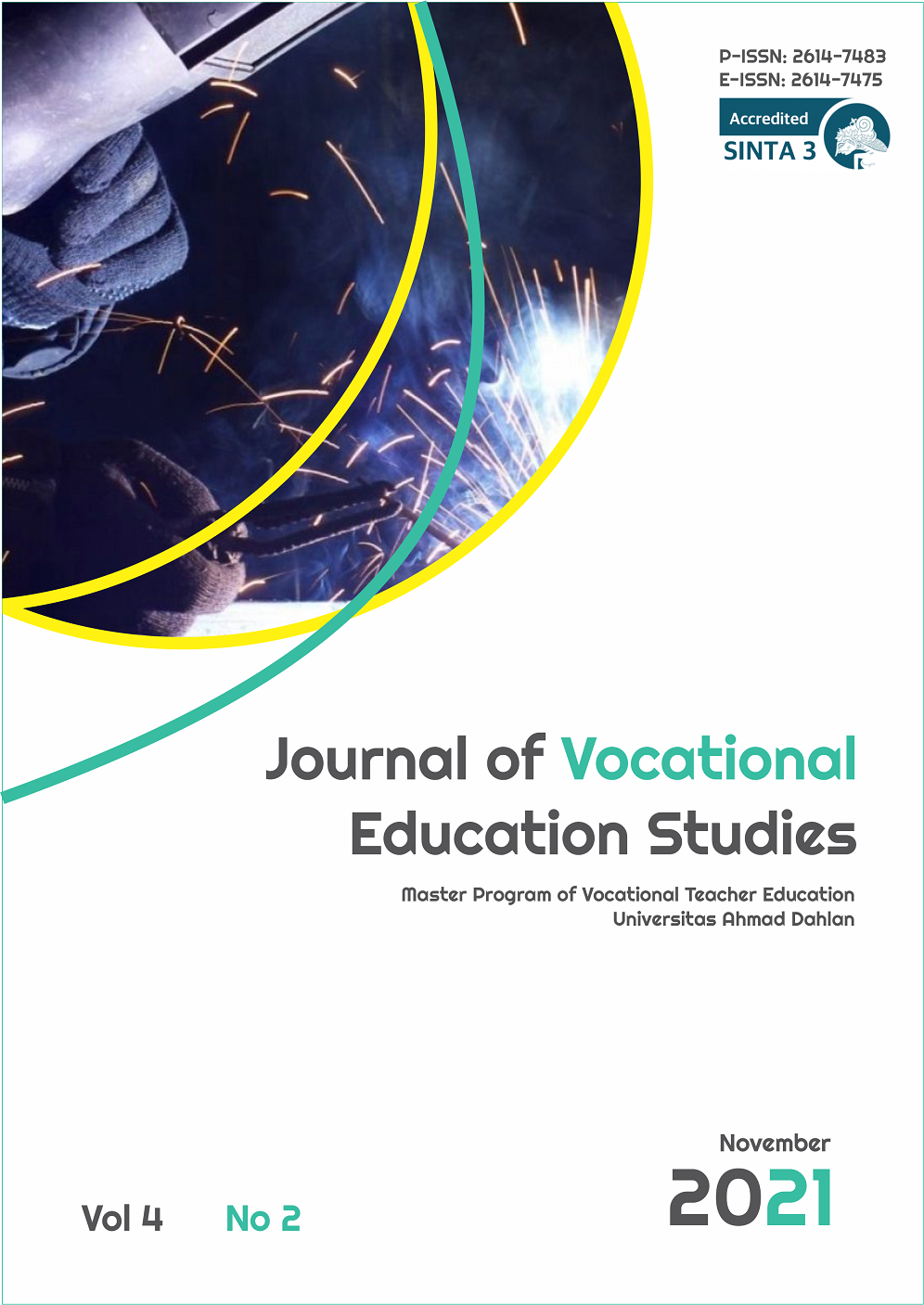The Expert Perception on Development and Usability of Teaching Aids ‘Kit’ Mini Model (Cage System) for Aquaculture Course
DOI:
https://doi.org/10.12928/joves.v4i2.4374Keywords:
ADDIE model, Teaching ‘Kits’, Mini-models, Cage systemAbstract
The increasing technology as changed the learning methods nowadays which clearly presents a new challenge to educators. Moreover, following the COVID-19 pandemic that hit the world at this time completely inhibits the teaching and learning process to be done entirely online. This clearly presents difficulties to teachers and students, as there are subjects that require practice to improve skills and better understanding. Among the limited access for teachers during the online learning and teaching process is that teachers can only explain and display pictures and show videos. At the same time, students need skills and understanding related to a subject studied. Also, students may not be able to accurately identify the types of systems found in the subjects studied. For example, for aquaculture subjects, the process of online teaching and learning can actually be done. However, this subject also requires practical and field work for students. In aquaculture subjects, in particular, teaching aids play an important role in understanding the cage farming system concept in the teaching process because there are various farming systems used in the aquaculture industry. The development of teaching aid is a crucial phase to make sure the teaching aids develop in accordance with the objectives and topics learning. Therefore, it is important to have an expert perception of the development and usability of the Teaching Aids kit mini model (Cage system). This study consisted of 9 experts as an evaluator consisting of experienced lecturers in the technical field of Faculty Technical. This study uses a quantitative assessment method (questionnaire).  A set of questionnaires was distributed to the experts to obtain the required information and data. All data obtained were analyzed using computer software' Statistical Package For Social Science SPSS version 24 to obtain the frequency, percentage and mean through descriptive statistic. The study's findings show that the level of experts' perception of “Teaching Aids kit mini model (Cage system) development and usability is necessary and positive. The study's conclusion illustrates the need for the development of a teaching aids kit mini model (cage system) for teachers to increase the level of understanding and skills of individual students in the teaching and learning process for aquaculture subjects.
References
Ali, H. I. H. & Abdalla Salih, A. R. (2013). Perceived views of language teachers on the use of needs analysis in ESP materials writing. English Language Teaching, 6(3), 11–19.
Azman, M. N. A., Azli, N. A., Mustapha, R., Balakrishnan, B. & Isa, N. K. M. (2014). Penggunaan alat bantu mengajar ke atas guru pelatih bagi topik kerja kayu, paip dan logam. Sains Humanika, 3(1).
Bacotang, J., Mohamed Isa, Z., Che Mustafa, M., Arshad, M. & Omar, A. (2016). Aplikasi Model Addie Dalam Pembangunan Modul Literasi Awal (Modul Lit-a) Untuk Awal Kanak-Kanak. Jurnal Pendidikan Bitara UPSI Edisi Khas, 9, 1-10.
Hamdan and Mohamad A’zmi, Surizan (2010) Penilaian Kesesuaian Bahan Bantu Mengajar Jangka Sudut Khas Bagi Mata Pelajaran Matematik. Penilaian Kesesuaian Bahan Bantu Mengajar Jangka Sudut Khas Bagi Mata Pelajaran Matematik . pp. 1-6.
Khairulameera. (2011). Kemahiran Pemilihan Dan Aplikasi Alat Bantu (ABM). https://khairulameera.wordpress.com/2011/10/20/ Kemahiran-pemilihan-dan-aplikasi-alat-bantu-mengajar-abm/[2 Jun 2021].
Kurt, S. (2019). ADDIE Model: Instructional Design. Educational Technology, 29.
Ilias, M. F., Ismail, M. F. & Jasmi, K. A. (2013). Faktor Dorongan dan Halangan Penggunaan Bahan Bantu Mengajar oleh Guru Pendidikan Islam di Sekolah Bestari. 3rd International Conference on Islamic Education 2013 [ICIED2013].
McKenney, S. & Reeves, T.C. (2013). Educational Design Research. In Handbook of
research on educational communications and technology, 131-140. New York:
Springer.
Najamuddin. (2017). Bahan bantu mengajar tingkat kemahiran dan kefahaman pelajar. Utusan Borneo Online. Tawau, Sabah, Malaysia. Retrieved from https://www.utusanborneo.com.my/2017/04/15/bahan-bantu-mengajar-tingkat-kemahiran-dan-kefahaman-pelajar.
Noor Azlan, A. Z. & Nurdalina. (2001). Penggunaan Bahan Bantu Mengajar Di Kalangan Guru Pelatih Utm. Jurnal Universiti Teknologi Malaysia, Fakulti Pendidikan, 1(1).
Othman Abdelaziz Ahmed, A. (2018). EFL Teachers’ and Students’ Approaches in Using Teaching Aids: A case Study. Arab World English Journal, 4(4), 109–124.
Omar, M. S., Saad, N. S. & Dollah, M. U. (2017). Penggunaan bahan bantu mengajar guru matematik sekolah rendah. Jurnal Pendidikan Sains Dan Matematik Malaysia, 7(1), 32–46.
Sönmez, H. (2019). An Examination of Needs Analysis Research in the Language Education Process. International Journal of Education and Literacy Studies, 7(1), 8.
Stapa, M. A. & Mohammad, N. (2019). The Use of Addie Model for Designing Blended Learning Application at Vocational Colleges in Malaysia. Asia-Pacific Journal of Information Technology & Multimedia, 08(01), 49–62.
Ulrahman, D., Saad, M., Husaini, M. H., Izzuddin, M., Pisol, M., Shafiq, A., Razali, M. & Mohd, S. (2017). Kekerapan Penggunaan Bahan Bantu Mengajar.1st International Conference on Research, Language, and Education (ICoRaLE2017).
Downloads
Published
Issue
Section
License
Copyright (c) 2021 Universitas Ahmad Dahlan

This work is licensed under a Creative Commons Attribution-ShareAlike 4.0 International License.
Authors who publish with Journal of Vocational Education Studies (JOVES) agree to the following terms: Authors retain the copyright and grant the Universitas Ahmad Dahlan right of first publication with the work simultaneously licensed under a Creative Commons Attribution License (CC BY-SA 4.0) that allows others to share (copy and redistribute the material in any medium or format) and adapt (remix, transform, and build upon the material) the work for any purpose, even commercially with an acknowledgement of the work's authorship and initial publication in Universitas Ahmad Dahlan. Authors are able to enter into separate, additional contractual arrangements for the non-exclusive distribution of the journal's published version of the work (e.g., post it to an institutional repository or publish it in a book), with an acknowledgement of its initial publication in Universitas Ahmad Dahlan. Authors are permitted and encouraged to post their work online (e.g., in institutional repositories or on their website) prior to and during the submission process, as it can lead to productive exchanges, as well as earlier and greater citation of published work (See The Effect of Open Access).










.png)



